SUBJECTS
GRADE
Show Results
Leaf Man
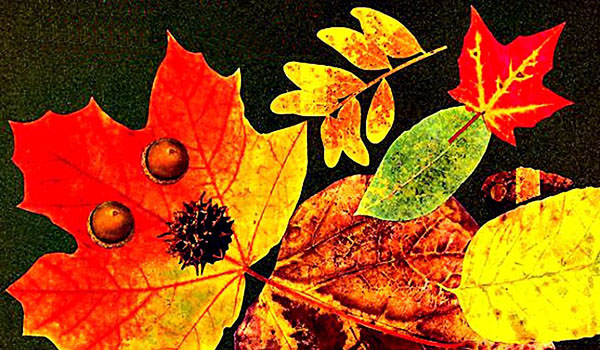
Lesson Summary
- Recognize movement, traveling pathways, and levels.
- Participate in a decision making creative process.
- Compose and perform a dance solo that conveys meaning.
Lesson Plan and Procedure
Lesson Key Facts
- Grade(s): K, 1, 2, 3, 4, 5
- Subject(s): Dance, English Language Arts, Science
- Duration of lesson: One or two sessions, 30-60 minutes each
- Author(s): Miriam Bowen
“A Leaf Man’s got to go where the wind blows”
This lesson could go in many directions, depending on the needs of your specific classroom. It includes a language arts section where you will read the book Leaf Man and broaden students’ vocabulary. In addition, there are menu options to choose from in the following categories: dance warm-ups, scientific discussions, and creating solos. Choose the options that best fit your learning objectives.
Menu 1: Dance Warm Up Essentials--Building Knowledge
Depending on the experience you and your students have had with movement in the classroom, choose one or more of the dance warm up options to build knowledge for the solo option you choose.
Dance Option 1: Exploring Levels
Teacher: In dance, level refers to how close or how far from the floor a dancer is moving. Levels can be identified as high, medium, and low. Use your hand as an indicator of the level I am saying.
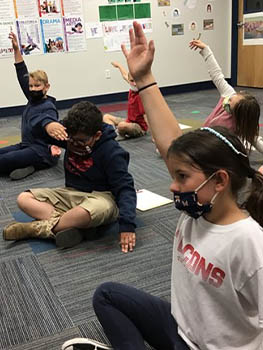 High—students lift a hand high in the air with fingers stretched upward.
High—students lift a hand high in the air with fingers stretched upward.
Medium—students bring the same hand to shoulder area.
Low—students lower the same hand close to the floor without touching it.
Teacher: As I call out each level, show that level with your hand. I will increase the speed and difficulty by mixing up the order and saying the levels faster and faster. We can form shapes and create designs with our bodies. Make a whole body shape on a high level, a medium level, and a low level. Try to make each of your shapes still or frozen, and different from the one before, for variety.
Instruct the students to move through each of these different shapes at a high, medium, and low level.
Dance Option 2: Exploring Pathways
Teacher: In dance, you move through the general space with your feet creating pathways. Pathways are the directional choices made to take your movement through the space. You can also create pathways in the air with your arms.
Pathways
- Draw a straight line on the board and ask the students to say “straight pathway.”
- Draw a curved line on the board and ask the students to say “curved pathway.”
- Draw a zigzag line on the board and ask the students to say “zigzag pathway.”
Shaping
Teacher: Make a shape with your arms that is straight, curved, zigzag, or angular. Say the words with me as you physically demonstrate each pathway. Let’s move on to whole body shapes with each pathway: straight, curved, and zigzag. Remember to use different levels for each shape to add interest.
Moving with Different Pathways
 Teacher: Locomotor movement is movement that travels through space, taking you from one place to another. Some locomotor movements are walking, running, hopping, jumping, skipping, galloping, sliding, and leaping. Keeping personal space around you will help our class stay safe as we travel. Keep yourself from bumping into anyone or anything.
Teacher: Locomotor movement is movement that travels through space, taking you from one place to another. Some locomotor movements are walking, running, hopping, jumping, skipping, galloping, sliding, and leaping. Keeping personal space around you will help our class stay safe as we travel. Keep yourself from bumping into anyone or anything.
Teacher: As I keep a rhythm with my hands, drum, or other musical instrument, begin walking in a straight pathway. When you need to change direction, make a sharp and quick turn and continue walking in a straight pathway.
Let’s change to a curved pathway.
While I keep a rhythm, or turn on music, think of a river or the letter “S” and softly run in a curved pathway. Keep your run slow and gentle as you look for the spaces that are empty, where nobody is moving. Now, jump from right to left alternately in sharp, angular lines like the letter “Z,” creating a zigzag pathway.
Creating
Teacher: You may now choose your favorite pathway and locomotor movement. You may want to explore all three pathways: straight, curved, and zigzag. Remember that in addition to thinking of the pathways where your feet are taking you, you can create pathways in the air using your arms, hands or other body parts.
Tap a drum or turn on music for this time of individual pathway exploration.
Dance Option 3: Exploring Space
Teacher: Self-space or personal space is the space around your own body. It is also called kinesphere, which means movement sphere. Imagine moving inside a large ball, your self-space. Within your self-space you can grow, shrink, twist, turn, hop, jump, balance and do a variety of movements. Take your pointing finger on both hands and imagine drawing a large circle around your body. Say self-space as you do this. Let’s try some movements within that circle.
Allow your students to explore moving in a variety of ways, within their self-space. You may use a drum or music as they move.
Teacher: General space is the big space we travel through while moving from one place to another. Within the general space we have corners, sides and middle places. Open your arms to the big space we are in and say “general space.” We share our general space with people and things. Our self-space is like a protective bubble as we travel through general space, helping us to avoid bumping into people and things.
Lead students in repeatedly identifying and practicing the use of self-space and general space.
Dance Option 4: Exploring Locomotor Movement
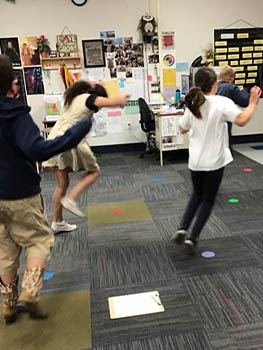 Teacher: Locomotor movement is movement that travels through space. Locomotor movements are the foundations of human movement and are essential for building strength and coordination. The eight basic locomotor movements are walking, running, hopping, skipping, jumping, galloping, leaping, and sliding. (Display the words on the board.)
Teacher: Locomotor movement is movement that travels through space. Locomotor movements are the foundations of human movement and are essential for building strength and coordination. The eight basic locomotor movements are walking, running, hopping, skipping, jumping, galloping, leaping, and sliding. (Display the words on the board.)
Teacher: Find a place in the room to begin. When I start tapping my drum, begin walking through the space. Watch for empty spaces to go and keep a personal space bubble around you so you do not bump into anyone or anything as you move.
Expand students’ locomotor movement exploration by trying any of the eight basic locomotor movements above or others such as: stretching, bouncing, exploding, flinging, spinning, floating, gliding, or any other movement you choose.
Menu 2: Scientific Discussions
Discuss what your students already know about the following scientific concepts according to the grade level. Introduce any new concepts you wish to add to their understanding.
Science Option 1: Examples of Discussion on Wind
- When the air around us moves, we call it wind.
- Cool air sinks, warm air rises; these air movements cause wind.
- Winds are measured by their strength and direction.
- Depending on strength, a wind can be a breeze, gale, storm, or hurricane.
- Wind direction is determined by the direction from which the wind blows.
- Wind has the ability to shape the surface of the earth.
- Wind may erode, transport, and deposit materials.
- Wind is a means of transportation for seeds, insects and birds.
- Wind is an essential part of weather and seasons.
- Winds are part of Earth's atmospheric circulation.
Science Option 2: Examples of Cycling of Matter in Ecosystems
- All things are made of matter which exists with different forms and properties.
- Matter cycles through living things.
- Matter is made of particles on a scale that is too small to be seen.
- The cycling of matter and flow of energy through systems includes transfer, transformation, and conservation of energy and matter.
- Living things change and depend upon their environment to satisfy basic needs.
- Trees conserve energy by losing their leaves when the weather gets colder and drier.
- Fallen leaves decompose (transform) and play an important part in returning (transferring) essential nutrients to the soil.
- Matter cycles within ecosystems and can be traced from organism to organism.
- Plants use energy from the Sun to change air and water into matter needed for growth.
- Animals and decomposers consume matter for their life functions, continuing the cycling of matter.
- Human behavior can affect the cycling of matter.
- Plants are producers in food webs, interacting with consumers and decomposers in various ecosystems.
Science Option 3: Examples of Life Cycle Changes of Organisms
- Plants have a lifecycle that tells how they change as they grow.
- Plants adapt to survive within their environment.
- Natural earth materials help to sustain plant life (such as nutrients, water, air and light).
- Plants depend on their surroundings to get what they need.
- Identify characteristics of living things (for example, growth, movement, reproduction).
- Organisms have unique and diverse life cycles but follow a pattern of birth, growth, reproduction, and death.
- The physical characteristics of plants reflect the habitat in which they live.
- Plants and animals have internal and external structures that function to support survival, growth, behavior, and reproduction.
English Language Arts
Reading Leaf Man
Teacher: As I read the book Leaf Man by Lois Ehlert, pay close attention to the words, illustrations and page design. Notice how the pictures collaborate with the words to create mood and emphasize aspects of the setting. Notice the leaf shapes and combinations that are arranged to look like different objects. Look closely at the lines and designs of each page, along with the levels and pathways in Leaf Man’s journey.
Read the book Leaf Man by Lois Ehlert.
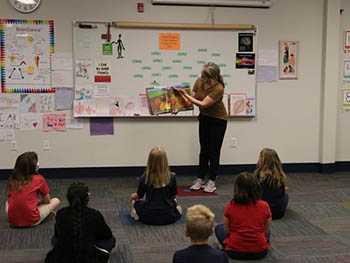 Teacher: Now that we know about the adventure the wind took Leaf Man on, lets create a moving adventure of our own. In dance, choreography is planned movement. You will be able to make choices and plan your own adventure.
Teacher: Now that we know about the adventure the wind took Leaf Man on, lets create a moving adventure of our own. In dance, choreography is planned movement. You will be able to make choices and plan your own adventure.
Teacher: Descriptive language is vivid and specific. It helps the reader visualize or imagine a scene or idea. Think of various words inspired by movement. Similarly, think of various movements inspired by words. These words will describe how we will be moving to convey meaning.
Use words from the lists below, or any of your choosing, to broaden vocabulary and inspire movement.
Leaf Man provides a wealth of ideas for choreography. Choose the solo option that best fits your learning objectives.
Menu 3: Creating Solos--Intersecting Language and Movement
Teacher: Let’s create an adventure inspired by movement and words. Just as visual arts can add texture to the words of a story, their depth of meaning can likewise be magnified through movement.
Solo Option 1: Movement Maps
Design a movement map to provide a framework for movement motifs. A movement map will enable students to plan literal ideas and then transfer those to a more abstract representation of their intent, by organizing each movement into a form of communication. The movement map will be a useful resource assisting students with visualization of their creative choices, and descriptive words that guide those choices. It will demonstrate to the teacher the underlying plan of each student’s creative work. Locomotor movement can be used to abstractly represent ideas.
Create a Class Movement Map
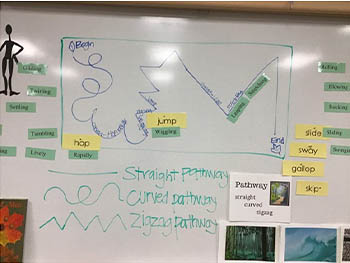 Draw a large perimeter representing your classroom space on the board. Within the area, draw where your beginning or starting place will be. Then draw where you will end. Have the students help you design the middle by adding straight, curved, and zigzag pathways as shown in dance option two. Keep it simple, using each pathway once as you draw lines that link your beginning to the ending. Now write a verb determining how to move along each pathway line. Depending on the grade, a modifying adverb can be added beside each verb to direct how you will move along each pathway, such as zigzag, jumping, suddenly--straight, leaping, energetically--curved, twirling, gracefully.
Draw a large perimeter representing your classroom space on the board. Within the area, draw where your beginning or starting place will be. Then draw where you will end. Have the students help you design the middle by adding straight, curved, and zigzag pathways as shown in dance option two. Keep it simple, using each pathway once as you draw lines that link your beginning to the ending. Now write a verb determining how to move along each pathway line. Depending on the grade, a modifying adverb can be added beside each verb to direct how you will move along each pathway, such as zigzag, jumping, suddenly--straight, leaping, energetically--curved, twirling, gracefully.
Teacher: We can liken the floor in our room to our white board movement map. Help me determine where the beginning and ending spots will be. Let’s review the pathway sequence we created for our middle. Now let’s put it all together moving from our beginning, through our middle to our end. Make a beginning shape at the place we marked for our beginning. Now let’s travel through our pathway sequence using the verbs and adverbs we chose.
Once you have moved through the movement map as a class, ask for a volunteer or two willing to dance our class movement map.
 Invite a few willing participants to demonstrate as a solo, or duet. Have them begin with an interesting shape. You may have the class help call out the pathway, locomotor verb and movement quality adverb to guide the dancers to the ending point, where they will finish with a different interesting shape than they began with. You may repeat this activity with additional students.
Invite a few willing participants to demonstrate as a solo, or duet. Have them begin with an interesting shape. You may have the class help call out the pathway, locomotor verb and movement quality adverb to guide the dancers to the ending point, where they will finish with a different interesting shape than they began with. You may repeat this activity with additional students.
Create an Individual Movement Map:
Give each student a pencil and a piece of blank paper on top of a hard surface. Have them write their name on the paper.
Teacher: We will follow the same steps of our class movement map as we create our own movement maps. Choose where you will begin and mark it. Choose where you will end and mark it. Next, you may make your own pathway choices connecting your beginning to your ending. Now that you have a pathway map, choose a locomotor movement to write next to each pathway line. Now, add a modifying adjective that can guide how you will do your locomotor movement.
Allow students to practice their sequence with music playing softly in the background. Encourage them to give their best energy and work to prepare for sharing their work in a performance.
Solo Option 2: Write a Leaf Metaphor
Teacher: A metaphor is a figure of speech that is used to make a direct comparison between two unlike things. Metaphors add details and help paint pictures in the mind. Writers and poets use metaphors as a way of explaining or referring to something in a brief but effective way, such as “a leaf is a star shimmering in the sky”.
Teacher: Choose a leaf or two from the collection of various shapes and sizes displayed, 1-2 crayon pieces and 2 pieces of paper. Place the leaf with its bottom side facing up under a piece of blank paper. With broken crayon pieces, rub the side of the crayon over the entire leaf. As you use good pressure you will see the design of the leaf begin to show on your paper. More than one color may be added. Do this until the shape of the leaf can be seen, and your art work is complete.

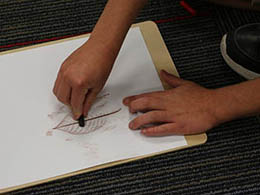
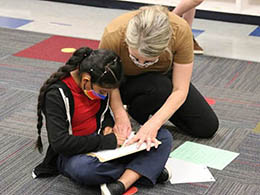
Teacher: Use your imagination as you look at the design of your leaf and think of something unlike it, that you can compare it to. Once you have made a comparison, begin constructing a metaphor.
Teacher: On a separate piece of paper write a rough draft of your metaphor. When you are pleased with your metaphor, transfer it to your leaf art paper. Use the words you have chosen and decide how to communicate them through movement.
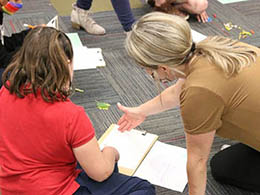
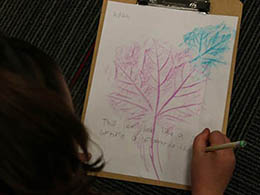
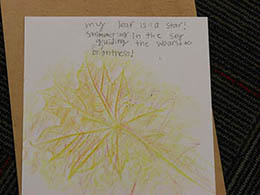
Teacher: To choreograph a dance, choose a beginning shape inspired by your leaf. Next choose movement that can communicate the meaning of your metaphor. Allow your words to inspire your movement. End your dance with a different shape than you began with.
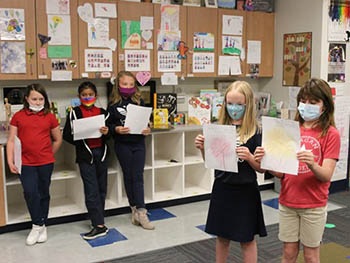 Allow students to practice their leaf metaphor dance sequence with music playing softly in the background. Encourage them to give their best energy and work to prepare for sharing their work in a performance.
Allow students to practice their leaf metaphor dance sequence with music playing softly in the background. Encourage them to give their best energy and work to prepare for sharing their work in a performance.
Performance note: Students may read their metaphor, show their artwork, and then perform their dance solo, or they may memorize their metaphor and say it as they perform their dance.
Solo Option 3: Write a Leaf Simile
Teacher: A simile is a way of describing something in an interesting or imaginative way by comparing it to something else using like or as, such as “my leaf is like a pointed star shining in the sky”.
Teacher: Choose a leaf or two from the collection of various shapes and sizes displayed, 1-2 crayon pieces, and a blank piece of paper. Place the leaf with its bottom side facing up under a piece of blank paper. With broken crayon pieces, rub the side of the crayon over the entire leaf. More than one color may be added. Do this until the shape of the leaf can be seen, or your artwork is complete.
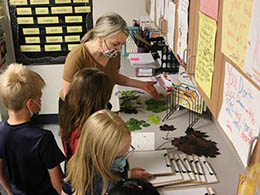
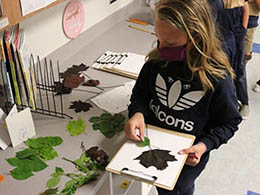
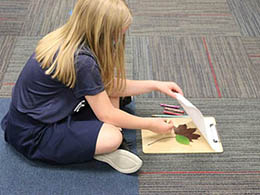
Teacher: Think about the shape of your leaf and what you want to say about it. Think of a second thing that shows the same, or a similar quality or characteristic. Combine them by saying the leaf is like the second thing.
Teacher: To choreograph a dance, choose a beginning shape inspired by your leaf. Next choose movement that can communicate the meaning of your simile. Allow your words to inspire your movement. End your solo with a different shape than you began with.
Allow students to practice their leaf simile dance sequence with music playing softly in the background. Encourage them to give their best energy and work to prepare for sharing their work in a performance.
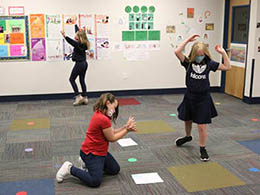
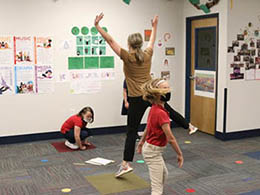

Performance note: Students may read their simile, show their artwork, and then perform their solo, or they may memorize their simile and say it as they perform their dance.
Solo Option 4: Write Prepositional Phrases
When you read the book Leaf Man, call your students attention to the use of prepositional phrases. Point out the preposition and the object it governs. Follow the steps in “Solo Option 1: Movement Maps” but have your students add a prepositional phrase alongside each pathway rather than a verb and adverb.
Allow students to practice their prepositional phrase dance sequence with music playing softly in the background. Encourage them to give their best energy and work to prepare for sharing their work in a performance.
Practice:
Turn on music and allow students to practice their individual sequences for several minutes. They can take the paper with them to help remember the sequence. If they are ready for a challenge, encourage them to memorize their sequence and words. Walk through the room assisting students as necessary. When ready, hold an informal performance.
Performance Guidelines
Establish a No Laughing Policy.
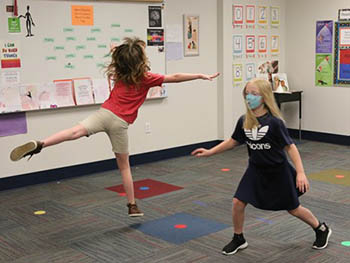 Teacher: As students in our class are expressing their solos, there will be no laughing by performers or audience. We have done our best work and this is a serious performance, not a comedy. We want our room to be a safe space where we can express ourselves in an atmosphere of respect and support.
Teacher: As students in our class are expressing their solos, there will be no laughing by performers or audience. We have done our best work and this is a serious performance, not a comedy. We want our room to be a safe space where we can express ourselves in an atmosphere of respect and support.
Guidelines for Professional Performing
- Perform with clear intentional movement and best energy and effort.
- Present your solo with professionalism and expressive movement.
- Hold beginning and ending shapes still.
- If you forget or make a mistake, keep going and doing your best.
Guidelines for Respectful and Responsible Audience Behavior
- Sit quietly and give performers your full attention.
- Find value and excellence in the expressions of others and their efforts.
- Applaud enthusiastically by clapping while performers hold ending shapes.
- Appreciate the performance by thinking of positive feedback.
Students acquire performance skills through practice and experience. Divide the class into small groups. Take turns performing and observing the solo’s that have been created. Display their artwork in a prominent place.
Reflect and Respond
Positive feedback is vital. Guide students to reflect and respond in positive ways.
- As the teacher, share the good you noticed or what you loved. Compliment your students on their courage and professionalism.
- Students may write or draw a few things that made their experience memorable.
- Students may pair and share one or two positive observations with each other.
- The teacher may call on two or three audience members to share the good they noticed.
- Guide students to make positive connections to the objectives you have chosen to teach within this lesson.
Reflection Prompts
Teacher:
- Did it take courage to share our solos with each other?
- How do you feel about doing something that took courage?
- How did watching the performance make you feel?
- How did performing your choreography make you feel?
- What did you find most exciting or interesting in the solos?
- What is the part you remember best?
- What made the performance interesting and unique?
- What did you enjoy most, performing or observing?
Learning Objectives
- Engage in reading with purpose and understanding.
- Understand the central message of a book.
- Recognize the effects of wind in weather.
- Notice movement patterns and pathways of leaves blown by the wind.
- Understand levels, and pathways and the part they play in movement.
- Identify words that can be demonstrated through movement.
- Determine the meaning of movement related words.
- Identify the role of illustrations and how they contribute to what is conveyed in the text to create mood and emphasize aspects of a setting.
- Express a variety of energy qualities while dancing.
- Demonstrate clear pathways and intent.
- Dance for others using performance etiquette.
- Design a movement map with a beginning, middle, and end.
- Perform an original dance inspired by the movement of blowing leaves.
- Apply and demonstrate problem solving skills along with critical and creative thinking to convey meaning through a choreographed solo.
- Use figurative language such as metaphors and similes.
Utah State Board of Education Standards
This lesson can be used to meet standards in many grades and subject areas. We will highlight one grade’s standards to give an example of application.
Grade 1 English Language Arts
Standard 1.R.8:
Identify specific words and phrases that express emotion, appeal to the senses, and/or determine the meaning of content-specific words within a text. (RL & RI)
Grade 1 Science with Engineering Education
Strand 1.2: THE NEEDS OF LIVING THINGS AND THEIR OFFSPRING
Living things (plants and animals, including humans) depend on their surroundings to get what they need, including food, water, shelter, and a favorable temperature. Plants and animals have external features that allow them to survive in a variety of environments. Young plants and animals are similar but not exactly like their parents. In many kinds of animals, parents and offspring engage in behaviors that help the offspring to survive.
Standard 1.2.3: Obtain, evaluate, and communicate information about the patterns of plants and nonhuman animals that are alike, but not exactly like, their parents. An example could include that most carrots are orange and shaped like a cone but may be different sizes or have differing tastes. (LS3.A, LS3.B)
Grade 1 Dance
Standard 1.D.P.1: Demonstrate moving safely through the space using a range of activities and in and out of spatial arrangements while maintaining personal space.
Standard 1.D.P.2: Make still and moving body shapes that show contrast.
Equipment and Materials Needed
- Blank paper
- Pencils
- Vocabulary pages and word strips
- Drum
- Music source
- Leaves of all shapes and sizes
- Broken crayon pieces
Additional Resources
- Music suggestions
- "Wind Song" by Tim Janis https://www.youtube.com/watch?v=5XbcjoX4SKE
- Detailed Sounds of Falling Leaves and Wind Blowing https://www.youtube.com/watch?v=aT66uumZ0Zo&t=2511s
- Wind Blowing Across Forest and Meadows https://www.youtube.com/watch?v=0JNxsGTatWo
- Strong Howling Wind Sound https://www.youtube.com/watch?v=sT5f1jBJHng
- Purple Rocks Ferenc Hegedus https://www.youtube.com/watch?v=henbW47ZMac
- Inspirational quotes
- “Learning is experience. Everything else is just information.” --Albert Einstein
- “Look deeply into nature, and then you will understand everything better.” --Albert Einstein
- “When we try to pick out anything by itself we find it hitches to everything in the universe.” --John Muir
- Leaf Man read aloud: https://www.youtube.com/watch?v=bqW-j3WV6g8&t=38s
- Make a leaf man: https://www.metroparks.com/wp-content/uploads/2020/03/Leaf-Man.pdf?x91894&x91894
- Free Download: https://www.yumpu.com/en/document/view/63205263/download-leaf-man-free-read-download
- Create a Leaf Man Collage: https://www.youtube.com/watch?v=UlcOvu4rZgs
- Create a leaf collage: https://www.youtube.com/watch?v=6A3q1zujLUg
- Nature collages: https://za.pinterest.com/pin/523613894166615394/
- Books for lesson extensions
- The Boy Who Spoke to the Earth by: Chris Burkard (David McClellan, Illus.)
- Red Leaf, Yellow Leaf by: Lois Ehlert
- Sky Tree by: Thomas Locker
- Because of an Acorn by: Lola M. Schaefer and Adam Schaefer (Frann Preston-Gannon Illus.)
- You’re Here for a Reason by: Nancy Tillman
- Plants Can’t Sit Still by Rebecca E. Hirsch (Mia Posada Illus.)
- Tall Tall Tree by: Anthony D. Fredericks (Chad Wallace Illus.)
- A Seed is Sleepy by: Dianna Hutts Aston (Sylvia Long Illus.)
- Weeds Find a Way by: Cindy Jenson-Elliott (Carolyn Fisher Illus.)
- If You Plant a Seed by: Kadir Nelson
- How to be an Explorer of the World by: Keri Smith
Image References
Image 1: https://www.tes.com/teaching-resource/leaf-man-planning-ks1-11690036
Images 2-21: James Huston and Miriam Bowen

www.education.byu.edu/arts/lessons
 Download
Download